International Business Perspective: Smart Mirror Prototype Project
VerifiedAdded on 2023/06/04
|5
|1166
|164
Project
AI Summary
This project examines the development and testing of a smart mirror prototype aimed at improving study habits among university students. The project involved interviewing three students with varying study habits and work commitments to assess the prototype's effectiveness. The smart mirror was designed to help students manage their time, prioritize tasks, and set reminders. The project highlights the challenges students face in balancing academics, work, and personal life, and how the prototype could address these issues. The insights gained from the interviews revealed the need for language options and emphasized the importance of student discipline for the product's success. The project also discusses the motivations behind studying and the different needs of students, which should be considered in future developments.
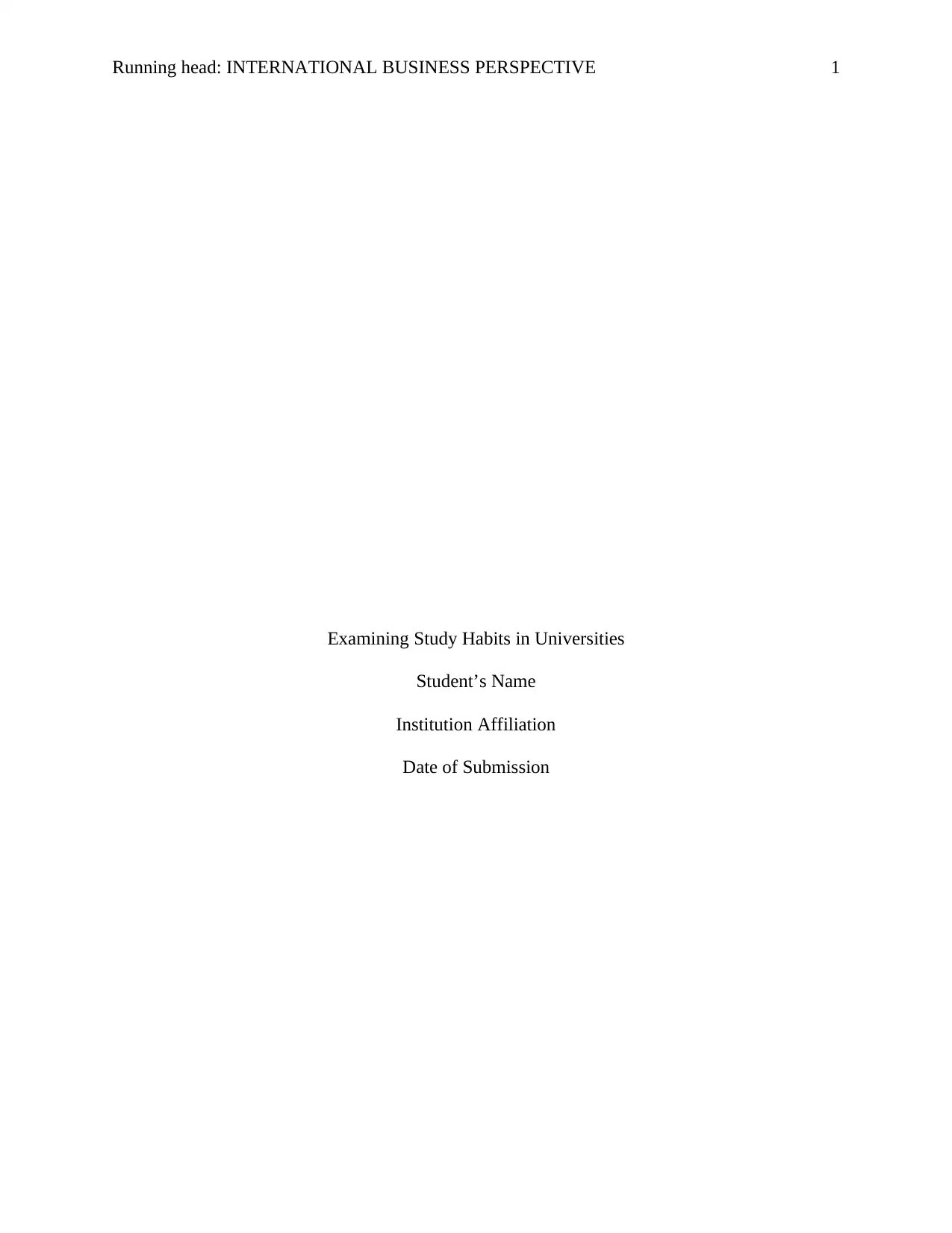
Running head: INTERNATIONAL BUSINESS PERSPECTIVE 1
Examining Study Habits in Universities
Student’s Name
Institution Affiliation
Date of Submission
Examining Study Habits in Universities
Student’s Name
Institution Affiliation
Date of Submission
Paraphrase This Document
Need a fresh take? Get an instant paraphrase of this document with our AI Paraphraser
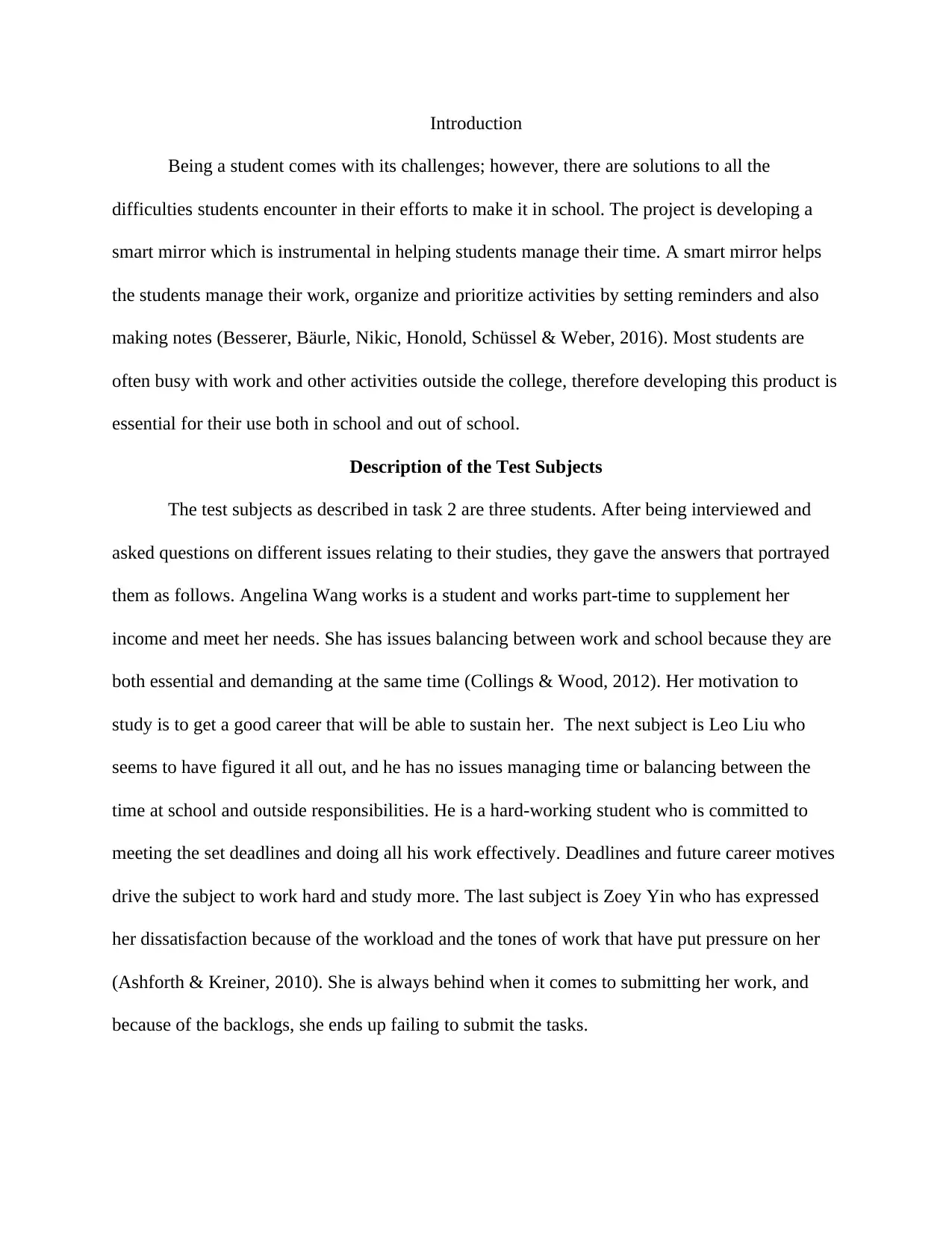
Introduction
Being a student comes with its challenges; however, there are solutions to all the
difficulties students encounter in their efforts to make it in school. The project is developing a
smart mirror which is instrumental in helping students manage their time. A smart mirror helps
the students manage their work, organize and prioritize activities by setting reminders and also
making notes (Besserer, Bäurle, Nikic, Honold, Schüssel & Weber, 2016). Most students are
often busy with work and other activities outside the college, therefore developing this product is
essential for their use both in school and out of school.
Description of the Test Subjects
The test subjects as described in task 2 are three students. After being interviewed and
asked questions on different issues relating to their studies, they gave the answers that portrayed
them as follows. Angelina Wang works is a student and works part-time to supplement her
income and meet her needs. She has issues balancing between work and school because they are
both essential and demanding at the same time (Collings & Wood, 2012). Her motivation to
study is to get a good career that will be able to sustain her. The next subject is Leo Liu who
seems to have figured it all out, and he has no issues managing time or balancing between the
time at school and outside responsibilities. He is a hard-working student who is committed to
meeting the set deadlines and doing all his work effectively. Deadlines and future career motives
drive the subject to work hard and study more. The last subject is Zoey Yin who has expressed
her dissatisfaction because of the workload and the tones of work that have put pressure on her
(Ashforth & Kreiner, 2010). She is always behind when it comes to submitting her work, and
because of the backlogs, she ends up failing to submit the tasks.
Being a student comes with its challenges; however, there are solutions to all the
difficulties students encounter in their efforts to make it in school. The project is developing a
smart mirror which is instrumental in helping students manage their time. A smart mirror helps
the students manage their work, organize and prioritize activities by setting reminders and also
making notes (Besserer, Bäurle, Nikic, Honold, Schüssel & Weber, 2016). Most students are
often busy with work and other activities outside the college, therefore developing this product is
essential for their use both in school and out of school.
Description of the Test Subjects
The test subjects as described in task 2 are three students. After being interviewed and
asked questions on different issues relating to their studies, they gave the answers that portrayed
them as follows. Angelina Wang works is a student and works part-time to supplement her
income and meet her needs. She has issues balancing between work and school because they are
both essential and demanding at the same time (Collings & Wood, 2012). Her motivation to
study is to get a good career that will be able to sustain her. The next subject is Leo Liu who
seems to have figured it all out, and he has no issues managing time or balancing between the
time at school and outside responsibilities. He is a hard-working student who is committed to
meeting the set deadlines and doing all his work effectively. Deadlines and future career motives
drive the subject to work hard and study more. The last subject is Zoey Yin who has expressed
her dissatisfaction because of the workload and the tones of work that have put pressure on her
(Ashforth & Kreiner, 2010). She is always behind when it comes to submitting her work, and
because of the backlogs, she ends up failing to submit the tasks.
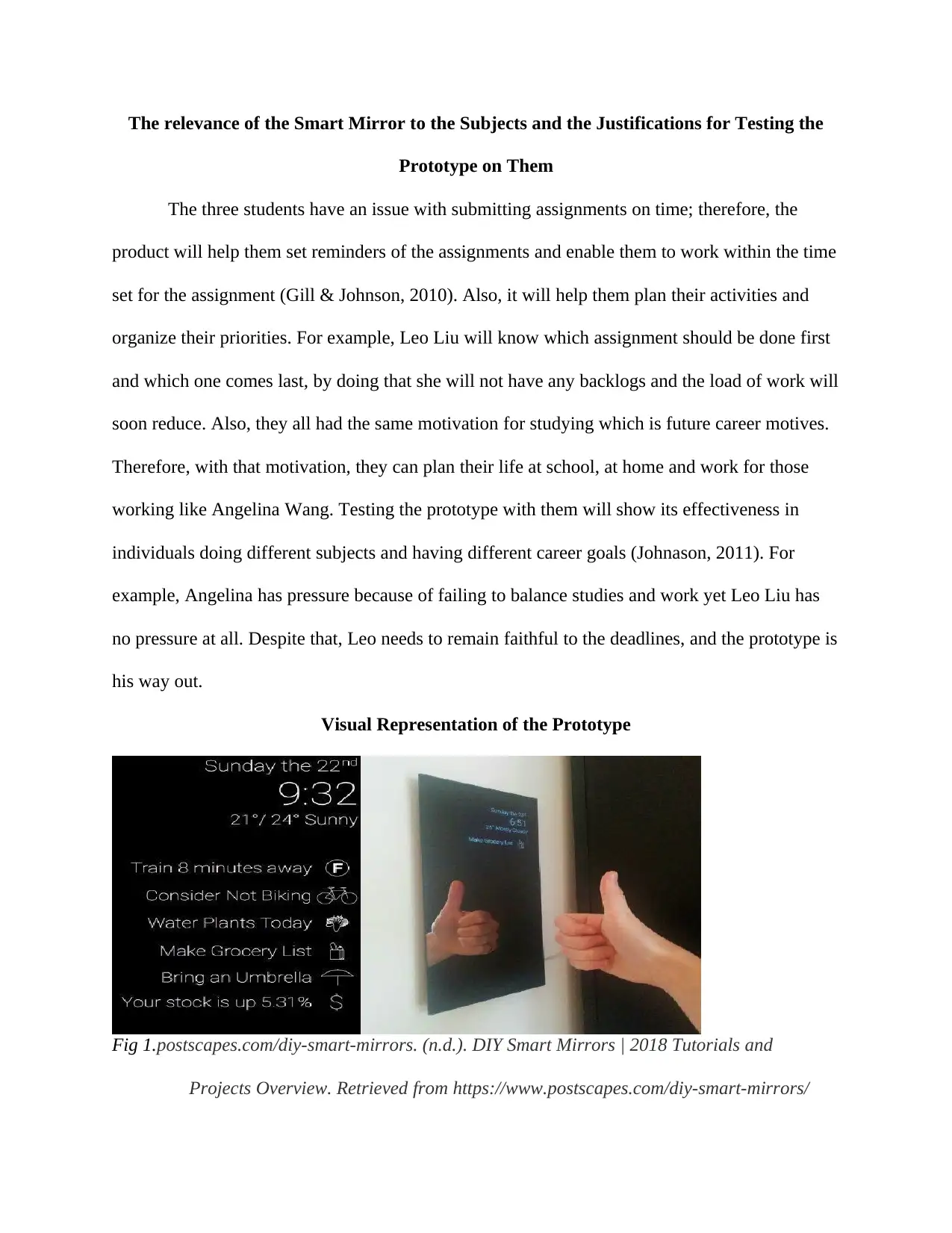
The relevance of the Smart Mirror to the Subjects and the Justifications for Testing the
Prototype on Them
The three students have an issue with submitting assignments on time; therefore, the
product will help them set reminders of the assignments and enable them to work within the time
set for the assignment (Gill & Johnson, 2010). Also, it will help them plan their activities and
organize their priorities. For example, Leo Liu will know which assignment should be done first
and which one comes last, by doing that she will not have any backlogs and the load of work will
soon reduce. Also, they all had the same motivation for studying which is future career motives.
Therefore, with that motivation, they can plan their life at school, at home and work for those
working like Angelina Wang. Testing the prototype with them will show its effectiveness in
individuals doing different subjects and having different career goals (Johnason, 2011). For
example, Angelina has pressure because of failing to balance studies and work yet Leo Liu has
no pressure at all. Despite that, Leo needs to remain faithful to the deadlines, and the prototype is
his way out.
Visual Representation of the Prototype
Fig 1.postscapes.com/diy-smart-mirrors. (n.d.). DIY Smart Mirrors | 2018 Tutorials and
Projects Overview. Retrieved from https://www.postscapes.com/diy-smart-mirrors/
Prototype on Them
The three students have an issue with submitting assignments on time; therefore, the
product will help them set reminders of the assignments and enable them to work within the time
set for the assignment (Gill & Johnson, 2010). Also, it will help them plan their activities and
organize their priorities. For example, Leo Liu will know which assignment should be done first
and which one comes last, by doing that she will not have any backlogs and the load of work will
soon reduce. Also, they all had the same motivation for studying which is future career motives.
Therefore, with that motivation, they can plan their life at school, at home and work for those
working like Angelina Wang. Testing the prototype with them will show its effectiveness in
individuals doing different subjects and having different career goals (Johnason, 2011). For
example, Angelina has pressure because of failing to balance studies and work yet Leo Liu has
no pressure at all. Despite that, Leo needs to remain faithful to the deadlines, and the prototype is
his way out.
Visual Representation of the Prototype
Fig 1.postscapes.com/diy-smart-mirrors. (n.d.). DIY Smart Mirrors | 2018 Tutorials and
Projects Overview. Retrieved from https://www.postscapes.com/diy-smart-mirrors/
⊘ This is a preview!⊘
Do you want full access?
Subscribe today to unlock all pages.

Trusted by 1+ million students worldwide
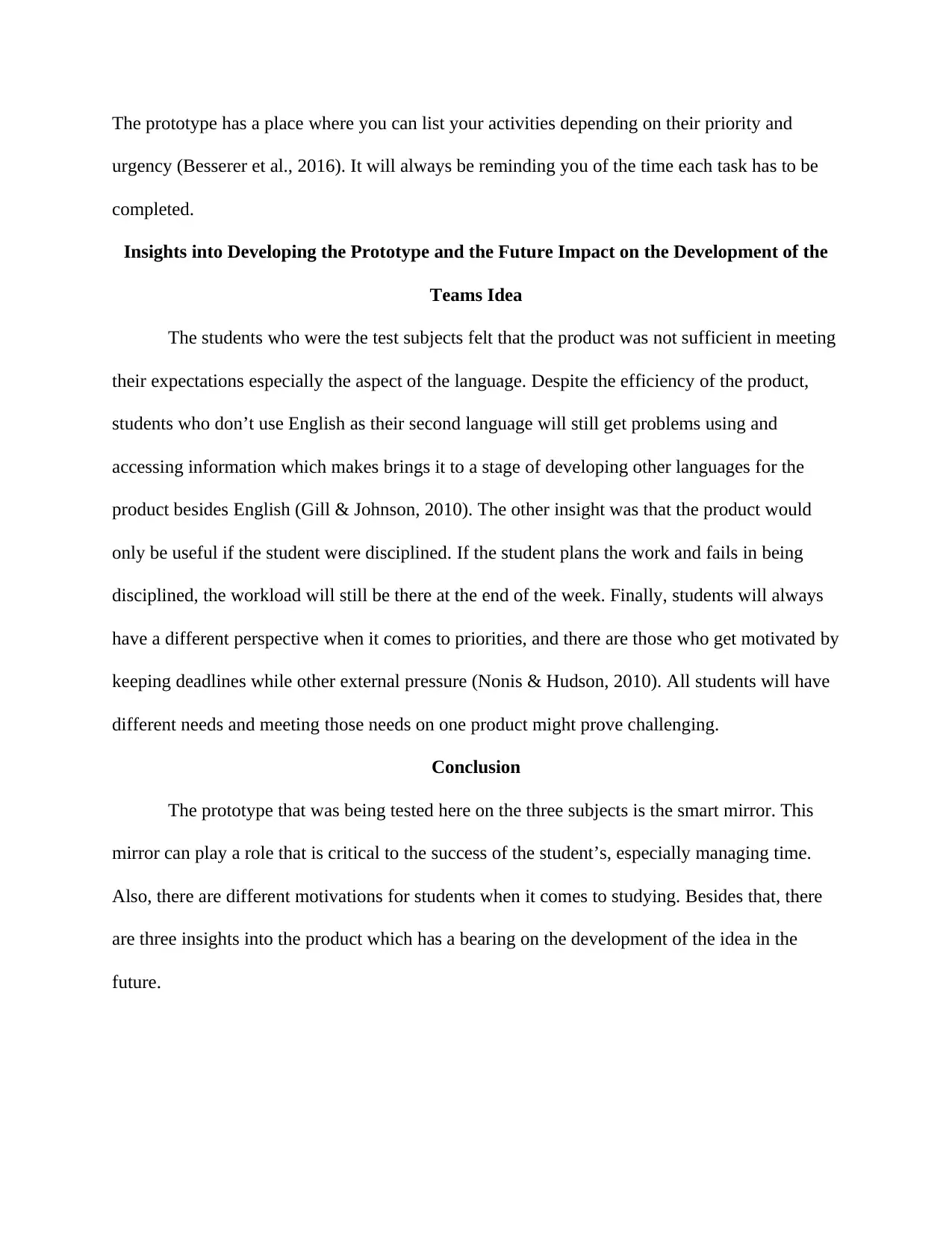
The prototype has a place where you can list your activities depending on their priority and
urgency (Besserer et al., 2016). It will always be reminding you of the time each task has to be
completed.
Insights into Developing the Prototype and the Future Impact on the Development of the
Teams Idea
The students who were the test subjects felt that the product was not sufficient in meeting
their expectations especially the aspect of the language. Despite the efficiency of the product,
students who don’t use English as their second language will still get problems using and
accessing information which makes brings it to a stage of developing other languages for the
product besides English (Gill & Johnson, 2010). The other insight was that the product would
only be useful if the student were disciplined. If the student plans the work and fails in being
disciplined, the workload will still be there at the end of the week. Finally, students will always
have a different perspective when it comes to priorities, and there are those who get motivated by
keeping deadlines while other external pressure (Nonis & Hudson, 2010). All students will have
different needs and meeting those needs on one product might prove challenging.
Conclusion
The prototype that was being tested here on the three subjects is the smart mirror. This
mirror can play a role that is critical to the success of the student’s, especially managing time.
Also, there are different motivations for students when it comes to studying. Besides that, there
are three insights into the product which has a bearing on the development of the idea in the
future.
urgency (Besserer et al., 2016). It will always be reminding you of the time each task has to be
completed.
Insights into Developing the Prototype and the Future Impact on the Development of the
Teams Idea
The students who were the test subjects felt that the product was not sufficient in meeting
their expectations especially the aspect of the language. Despite the efficiency of the product,
students who don’t use English as their second language will still get problems using and
accessing information which makes brings it to a stage of developing other languages for the
product besides English (Gill & Johnson, 2010). The other insight was that the product would
only be useful if the student were disciplined. If the student plans the work and fails in being
disciplined, the workload will still be there at the end of the week. Finally, students will always
have a different perspective when it comes to priorities, and there are those who get motivated by
keeping deadlines while other external pressure (Nonis & Hudson, 2010). All students will have
different needs and meeting those needs on one product might prove challenging.
Conclusion
The prototype that was being tested here on the three subjects is the smart mirror. This
mirror can play a role that is critical to the success of the student’s, especially managing time.
Also, there are different motivations for students when it comes to studying. Besides that, there
are three insights into the product which has a bearing on the development of the idea in the
future.
Paraphrase This Document
Need a fresh take? Get an instant paraphrase of this document with our AI Paraphraser
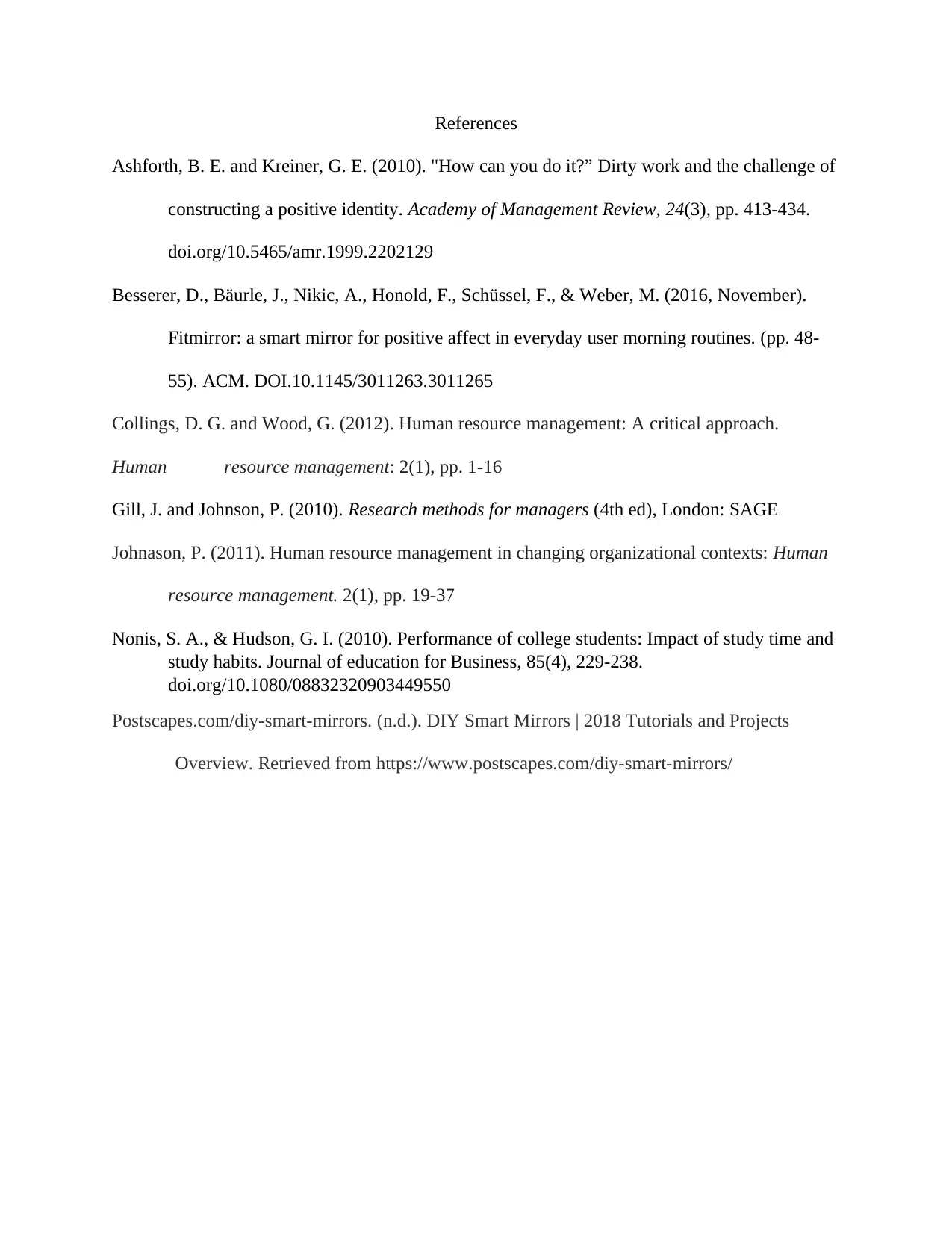
References
Ashforth, B. E. and Kreiner, G. E. (2010). "How can you do it?” Dirty work and the challenge of
constructing a positive identity. Academy of Management Review, 24(3), pp. 413-434.
doi.org/10.5465/amr.1999.2202129
Besserer, D., Bäurle, J., Nikic, A., Honold, F., Schüssel, F., & Weber, M. (2016, November).
Fitmirror: a smart mirror for positive affect in everyday user morning routines. (pp. 48-
55). ACM. DOI.10.1145/3011263.3011265
Collings, D. G. and Wood, G. (2012). Human resource management: A critical approach.
Human resource management: 2(1), pp. 1-16
Gill, J. and Johnson, P. (2010). Research methods for managers (4th ed), London: SAGE
Johnason, P. (2011). Human resource management in changing organizational contexts: Human
resource management. 2(1), pp. 19-37
Nonis, S. A., & Hudson, G. I. (2010). Performance of college students: Impact of study time and
study habits. Journal of education for Business, 85(4), 229-238.
doi.org/10.1080/08832320903449550
Postscapes.com/diy-smart-mirrors. (n.d.). DIY Smart Mirrors | 2018 Tutorials and Projects
Overview. Retrieved from https://www.postscapes.com/diy-smart-mirrors/
Ashforth, B. E. and Kreiner, G. E. (2010). "How can you do it?” Dirty work and the challenge of
constructing a positive identity. Academy of Management Review, 24(3), pp. 413-434.
doi.org/10.5465/amr.1999.2202129
Besserer, D., Bäurle, J., Nikic, A., Honold, F., Schüssel, F., & Weber, M. (2016, November).
Fitmirror: a smart mirror for positive affect in everyday user morning routines. (pp. 48-
55). ACM. DOI.10.1145/3011263.3011265
Collings, D. G. and Wood, G. (2012). Human resource management: A critical approach.
Human resource management: 2(1), pp. 1-16
Gill, J. and Johnson, P. (2010). Research methods for managers (4th ed), London: SAGE
Johnason, P. (2011). Human resource management in changing organizational contexts: Human
resource management. 2(1), pp. 19-37
Nonis, S. A., & Hudson, G. I. (2010). Performance of college students: Impact of study time and
study habits. Journal of education for Business, 85(4), 229-238.
doi.org/10.1080/08832320903449550
Postscapes.com/diy-smart-mirrors. (n.d.). DIY Smart Mirrors | 2018 Tutorials and Projects
Overview. Retrieved from https://www.postscapes.com/diy-smart-mirrors/
1 out of 5
Your All-in-One AI-Powered Toolkit for Academic Success.
+13062052269
info@desklib.com
Available 24*7 on WhatsApp / Email
![[object Object]](/_next/static/media/star-bottom.7253800d.svg)
Unlock your academic potential
Copyright © 2020–2025 A2Z Services. All Rights Reserved. Developed and managed by ZUCOL.


